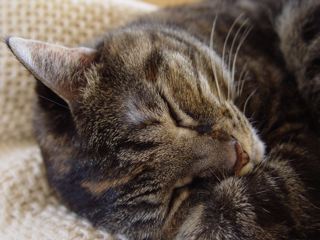A little under two months ago, word reached me that Shelby Gomas – the founder of Feline’s Pride – passed away. I’ve wanted to write something, say something, for the longest time, but I’ve been without words.
The words came, clumsily, this morning, when my husband and I were making cat food and we ran out of enough glass jars to put the food in. We looked at each other and agreed, “Yup, we’re going to have to use the Shelby containers.”
The Shelby containers. Shorthand for the square plastic storage boxes we’d accumulated dozens of over the years from purchases of Feline’s Pride food – known affectionately in our house as “Uncle Shlebee’s food.” (Long story.)
When I went into the basement pantry to retrieve them, I spied the tall stack of plastic containers that had once protected pound after pound of frozen, healthy, magnificent raw food I’d gladly fed our critters. My heart sunk a little knowing I couldn’t email Shelby and share my goofy little story about how he’d come to mind this cold January day. He’d have laughed if I’d written, “Hey Shelby! When I see stacks of petroleum-based food storage units, I think of you!”
Shelby hatched the idea of Feline’s Pride a few years back after I ran into him on the Feline IBD Yahoo e-group. He’d seen firsthand how a carefully prepared, correctly served raw meat based diet was the healthiest thing for carnivores and launched his company, selling about the only pre-made raw cat food I ever felt comfortable buying. Shelby “got it” about what was truly appropriate for carnivores, and didn’t fall prey to the common folly that other raw cat food manufacturers did – which was to toss in all kinds of healthy-sounding – but entirely species-inappropriate – ingredients like blueberries and flax seed and potatoes.
Don’t get me wrong – I’m happy to see more companies elbowing their way into the business of making healthy, fresh, cat food. But I will always hold out immense respect for those that shy away from adding what amounts to filler – under the anthropomorphic fantasy that what’s very healthy for humans is appropriate for small cats – even though it’s tempting and easy to market such formulas.
Shelby was special. He was very funny. He adored his animals. And he saw every cat who ate the food he made as an adoptee.
Having been a homemade cat food advocate for a long time, I never felt comfortable serving any food I hadn’t made myself. But when Feline’s Pride came along, I started supplementing the food I made with orders from Shelby. Anyone who knows me – and what a fussbudget I am about what goes into my cat’s food and my innate suspicion about anything anyone else prepares – knows that I must have had a very high degree of trust to serve someone else’s food.
The cardboard boxes with the food inside almost invariably arrived with special gifts for the cats — homemade catnip toys and sometimes even a personal note of affection for Duke and Nettie. For about a year there, I found myself getting ‘lazy’ and just buying Feline’s Pride. I put my grinder away, and was frankly grateful as life and my job got more busy that I was able to buy and confidently serve cat food that was as good as anything I could make at home.
I went back to making my own food all of the time in the middle of 2010, in part because – frankly – I missed doing it. And because after losing Duke earlier in the year, I wanted to return to the labor of love that began because of Duke.
It’s staggering to think of how much love-charged water has passed under the bridge since a handful of us first started waking up to the the importance of reexamining the whole paradigm of feeding small cats. The founder and moderator of the Feline IBD e-group, Lee Ellis, started her own pet sitting service, and continues to share the word with her clients about the benefits and wisdom of a healthy diet. One of the godmothers of raw feeding, my first mentor, Michelle Bernard, has taken her knowledge and insight on healthy feeding for cats and become a vigorous advocate for healthy raw diets for her beloved dogs.
Natascha Wille of the Raw Meat Cat Food Company (formerly Feline Future) remains, after over 15 years, an articulate and insightful advocate for raw feeding. Then there’s wonderful Margaret Gates, who launched an amazing movement and site with the Feline Nutrition Education Society – and some of the best ‘educational commercials’ online sharing the important message about raw feeding – without ever getting preachy or so weird no one will watch. It’s an amazing site.
And Dr. Lisa Pierson – who I am honored to count as a friend – has a recently revamped website on cat care that knocks it out of the ballpark when it comes to one-stop shopping for thoughtful, sound, advice on every aspect of cat health, including nutrition.
Then? Then there was Shelby. An upstart if there ever was one. His vision and passion – much more than his business sense (I’m guessing) – were what kept him going, but bless him for that. He always put cats first. And talk about someone with a heart always in the right place.
Thank you, Shelby, for making such a difference when you were here. Thank you for all the meals that my cats enjoyed because you made them when I was too busy. Thank you for sharing your deep passion and love for our animal companions. If I had a hat on just now, I’d “doff it” to you.
You’re missed.
You were appreciated.
And there are many cats thriving and well today because of your dedication.
For all that, we are ever grateful.

